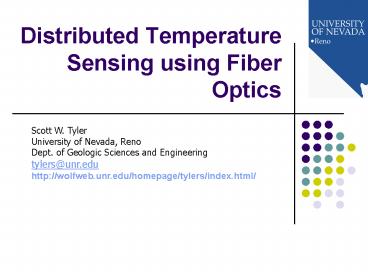Distributed Temperature Sensing using Fiber Optics - PowerPoint PPT Presentation
1 / 21
Title:
Distributed Temperature Sensing using Fiber Optics
Description:
The measurement of temperature (and possibly strain) using ... Instrument costs are likely to continue to come down. Power requirements are moderate to low. ... – PowerPoint PPT presentation
Number of Views:1642
Avg rating:5.0/5.0
Title: Distributed Temperature Sensing using Fiber Optics
1
Distributed Temperature Sensing using Fiber Optics
Scott W. Tyler University of Nevada, Reno Dept.
of Geologic Sciences and Engineering tylers_at_unr.ed
u http//wolfweb.unr.edu/homepage/tylers/index.htm
l/
2
What is Distributed Temperature Sensing (DTS)
- The measurement of temperature (and possibly
strain) using only the properties of a fiber
optic cable. - The fiber optic cable serves as the thermometer,
with a laser serving as the illumination source. - Measurements of temperature every 1-2 meters for
as long as 30 km can be resolved, every 1-60
minutes, with temperature resolution of
0.01-0.5oC
3
How Does it Work?
- Rayleigh, Raman and Brillouin scattering all
occur as light is passed through a fiber optic
cable, although all are small signals. Well
focus only on Raman in this talk. - Raman scattering is produced by inelastic
collisions of photons with atoms or molecules
along the fiber optic cable. If a photon loses
energy to the wall, the scattered wavelength is
longer (Stokes Signal) if a scattered photon
gains energy from the wall, its energy is larger
and therefore its wavelength is shorter
(anti-Stokes Signal)
4
From Agilent, Inc.
- The Raman wavelengths are predictable and
symmetric. - The anti-Stokes (energy gaining) is strongly
temperature dependant, but the Stokes is
relatively independent of the temperature of the
colliding molecule. - The temperature of the scatterer is calculated
from the ratio of the anti-Stokes/Stokes
Intensity.
5
According to Agilent Technologies.
6
Advantages of DTS
- The cable serves as the measuring device
- Fiber optic cable is relatively inexpensive
(0.50-10/meter) and robust (more on that
later!). - Cables typically have small thermal inertia.
- Once installed, continuous measurements do NOT
disturb the fluid column (wells) or soils. - Very high resolution and long cables can provide
high density coverage of a landscape, lake, or
groundwater reservoir.
7
Instrument Response and Costs
- Tool costs range from 30-60K
- Cable 1-10K
- Several manufacturers interested in environmental
applications - 30K instrument, 5 min. integration, 2 meter
spatial
8
Previous Applications
- DTS systems have been used to monitor geothermal
wells since 1993 - The bottom water temperature distribution (5 km)
of Lake Geneva was measured in 1998. - Applications to measure seepage through dams and
strain rate since 2002.
9
Sakaguchi and Matsushima (2000) showed reasonable
ability to detect fractures in geothermal wells
during Injection, and showed ability to measure
fluid level as shift over to steam.
10
Why DTS Now?
- Several key hydrology researchers have explored
new areas for DTS, and the costs are coming
down. - John Selker (Oregon State University)
Groundwater inflows to streams, mine shaft
circulation, high resolution lake and snow
profiling. - Fred Day-Lewis and John Lane (USGS)
stream/groundwater interaction tidal influences
on groundwaters in estuaries.
11
Selected Environmental Application Examples
- Measuring temporal changes in snow/ground
interface temperatures and ground freezing. - Circulation in boreholes, fracture mapping,
continuous borehole flowmeters - Groundwater inflows to streams (see Selker et al,
WRR and Day-Lewis et al., EOS) - Ephemeral stream flows
- Lake mixing and invasive species migration
- Fish habitat and habitat restoration
12
Circulation in Mine Shafts(Selker, Stekjal,
Zeman, Tyler and Lockington)
- Circulation in flooded Czech mines
- Thermal and salinity stratification
- Double diffusive steps clearly present
- DTS produced a very high resolution data without
disturbance to the fluid column
Steps in both T and S occur over lt1 m
13
Groundwater/Surface Water ExchangeCourtesy of
Fred Day-Lewis (USGS)
- Beginning in Spring 2006, the USGS Office of
Ground Water, Branch of Geophysics initiated a
demonstration/evaluation project for
DTS technology, with PI Fred Day-Lewis. - Study sites included (1) Waquoit Bay National
Estuarine Research Reserve, MA (2) bedrock wells
on the University of Connecticut campus (3) Fish
Creek , WY (4) the Shenandoah River, VA (5)
Allequash Creek , WI and (6) the San Pedro
River, AZ
14
Courtesy of Fred Day-Lewis USGS (Provisional)
15
Results
Courtesy of Fred Day-Lewis USGS (Provisional)
16
Issues and the Future
- Instrument costs are likely to continue to come
down. - Power requirements are moderate to low.
- Cables are well suited for boreholes.
- Surface placement can put the cable at risk from
breakage and rodents. More challenges in re-use. - Cables can be repaired AND cable manufacturers
are working with Agilent, Lios and Sensornet for
improved cables for environmental. - The future looks bright!!
17
Recent Hydrology-Related Publications
- Selker, J. S., L. Thévenaz, H. Huwald, A. Mallet,
W. Luxemburg, N. van de Giesen, M. Stejskal, J.
Zeman, M. Westhoff, M. B. Parlange (2006),
Distributed fiber-optic temperature sensing for
hydrologic systems, Water Resour. Res., 42,
W12202, doi10.1029/2006WR005326. - Selker, J.S., N. van de Geisen, M. Poolman, W.
Luxemburg and M. Parlange, In Press, Fiber Optics
Open Window on Stream Dynamics, Geophysical
Research Letters. - AGU NS24A MCS220 Tuesday 1600h
- NS24A-02 INVITED Monitoring Submarine
Ground-Water Discharge Using a Distributed
Temperature Sensor, Waquoit Bay, Massachusetts
Day-Lewis et al.
18
Extra Slides follow that may be of use to John
and Fred
19
Added Challenges
- Snow pack temperature experiment currently in
place at Mammoth, CA. - High winds relocated the cable several times
before the snow fell.
20
- Agilent Unit LIOS Unit
21
Sensornet DTS Halo Unit, Preliminary































